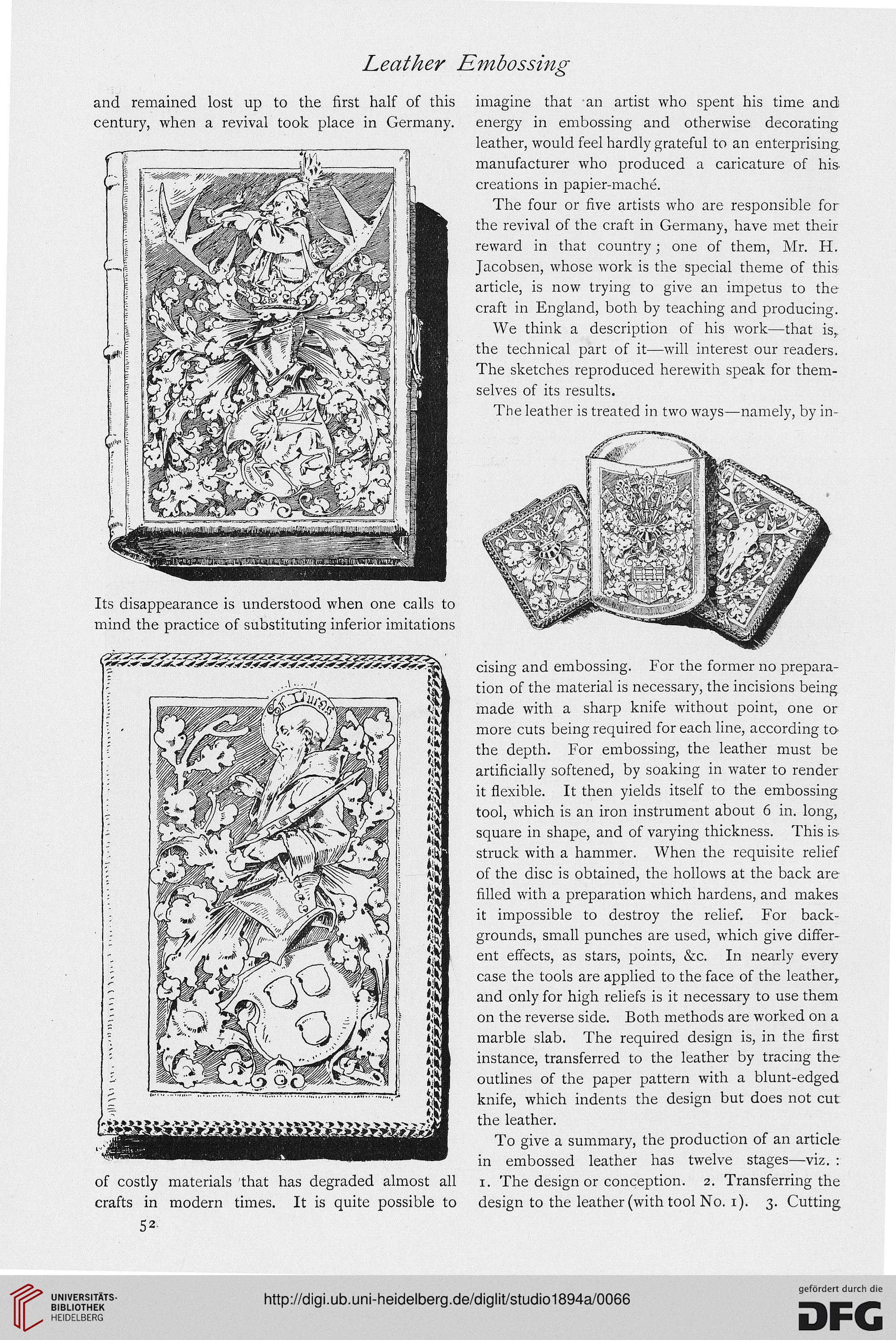Leather Embossing
and remained lost up to the first half of this
century, when a revival took place in Germany.
Its disappearance is understood when one calls to
mind the practice of substituting inferior imitations
of costly materials that has degraded almost all
crafts in modern times. It is quite possible to
52
imagine that an artist who spent his time and
energy in embossing and otherwise decorating
leather, would feel hardly grateful to an enterprising,
manufacturer who produced a caricature of his-
creations in papier-mache.
The four or five artists who are responsible for
the revival of the craft in Germany, have met their
reward in that country; one of them, Mr. H.
Jacobsen, whose work is the special theme of this
article, is now trying to give an impetus to the
craft in England, both by teaching and producing.
We think a description of his work—that is,,
the technical part of it—will interest our readers.
The sketches reproduced herewith speak for them-
selves of its results.
The leather is treated in two ways—namely, by in-
cising and embossing. For the former no prepara-
tion of the material is necessary, the incisions being
made with a sharp knife without point, one or
more cuts being required for each line, according to
the depth. For embossing, the leather must be
artificially softened, by soaking in water to render
it flexible. It then yields itself to the embossing
tool, which is an iron instrument about 6 in. long,
square in shape, and of varying thickness. This is-
struck with a hammer. When the requisite relief
of the disc is obtained, the hollows at the back are
filled with a preparation which hardens, and makes
it impossible to destroy the relief. For back-
grounds, small punches are used, which give differ-
ent effects, as stars, points, &c. In nearly every
case the tools are applied to the face of the leatherr
and only for high reliefs is it necessary to use them
on the reverse side. Both methods are worked on a
marble slab. The required design is, in the first
instance, transferred to the leather by tracing the
outlines of the paper pattern with a blunt-edged
knife, which indents the design but does not cut
the leather.
To give a summary, the production of an article
in embossed leather has twelve stages—viz. :
1. The design or conception. 2. Transferring the
design to the leather (with tool No. 1). 3. Cutting
and remained lost up to the first half of this
century, when a revival took place in Germany.
Its disappearance is understood when one calls to
mind the practice of substituting inferior imitations
of costly materials that has degraded almost all
crafts in modern times. It is quite possible to
52
imagine that an artist who spent his time and
energy in embossing and otherwise decorating
leather, would feel hardly grateful to an enterprising,
manufacturer who produced a caricature of his-
creations in papier-mache.
The four or five artists who are responsible for
the revival of the craft in Germany, have met their
reward in that country; one of them, Mr. H.
Jacobsen, whose work is the special theme of this
article, is now trying to give an impetus to the
craft in England, both by teaching and producing.
We think a description of his work—that is,,
the technical part of it—will interest our readers.
The sketches reproduced herewith speak for them-
selves of its results.
The leather is treated in two ways—namely, by in-
cising and embossing. For the former no prepara-
tion of the material is necessary, the incisions being
made with a sharp knife without point, one or
more cuts being required for each line, according to
the depth. For embossing, the leather must be
artificially softened, by soaking in water to render
it flexible. It then yields itself to the embossing
tool, which is an iron instrument about 6 in. long,
square in shape, and of varying thickness. This is-
struck with a hammer. When the requisite relief
of the disc is obtained, the hollows at the back are
filled with a preparation which hardens, and makes
it impossible to destroy the relief. For back-
grounds, small punches are used, which give differ-
ent effects, as stars, points, &c. In nearly every
case the tools are applied to the face of the leatherr
and only for high reliefs is it necessary to use them
on the reverse side. Both methods are worked on a
marble slab. The required design is, in the first
instance, transferred to the leather by tracing the
outlines of the paper pattern with a blunt-edged
knife, which indents the design but does not cut
the leather.
To give a summary, the production of an article
in embossed leather has twelve stages—viz. :
1. The design or conception. 2. Transferring the
design to the leather (with tool No. 1). 3. Cutting




